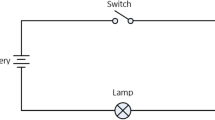Abstract
This paper discusses issues in building a conceptual modeling approach that has sufficient semantic power to represent the complexities of decision making in CIM systems. To express the information in a conceptual model we make use of an amalgam of powerful paradigms: a hybrid methodology, that integrates the concepts of object-oriented programming, messagepassing semantics, and temporal logic. We further illustrate an example incorporating some of these concepts.
Similar content being viewed by others
References
Adelsberger, H. H., Pooch, U. W., Shannon, R. E., and Williams, G. N. (1986) Rule based object-oriented simulation systems, inIntelligent Simulation Environments, Society for Computer Simulation, San Diego.
Agha, G. (1986) ACTORS:A model of concurrent computation in distributed systems, MIT Press, Cambridge, USA.
Allen, J. F. (1983) Maintaining knowledge about temporal intervals.CACM 26
Goldberg, A. and Robson, D. (1983)Smalltalk-80, the language and its implementation, Addison-Wesley, Reading, USA.
Hewit, C. (1977) Viewing control structures as patterns of passing messanges.Artificial Intelligence,8.
Hughes, D. and Maull, R. (1985) A framework for design of CIM system architecture.Computers in Mechanical Engineering,Sept.
Jackson, P., Reichgelt, H. and Harmelen, F. V. (eds) (1989)Logic Based Knowledge Representation, The MIT Press, Cambridge, USA.
King, C. U., Adams, S. S. and Fisher, E. L. (1987), Representation of manufacturing entities, in: Expert systems and the leading edge in production planning and control, Oliff, M. (ed.), Institute of Information Management, Technology and Policy, Amsterdam.
Kochan, D. (ed.) (1986)CAM developments in computer integrated manufacturing, Springer Verlag, Berlin
McDermott, D. (1982) A temporal logic for reasoning about processes and plans.Cognitive Science,6.
Moskowski, B. (1986)Executing temporal logic programs, Cambridge University Press, Cambridge, UK.
Talavage, J., Ruiz-Mier, S., Floss, P. and Guewa, A. (1986) Intelligent models for manufacturing planning and control, inCIDMAC Annual Report, Purdue University, West Lafayette, USA.
Thurwachter, P. E. (1986) Simplified integrated manufacturing (SIM): a byword for operational strategy, Systems integrating series, Part 7.Industrial Engineering,November.
Tseng, M. and O'Connor, D. O. (1986) Augmenting CIM with intelligent systems, inKnowledge-based expert systems for manufacturing, American Society of Mechanical Engineers, New York.
Turner, R. (1984)Logics for artificial intelligence, Horwood Limited, Chichester.
Williams, D. J. (1988)Manufacturing systems: an introduction to the technologies, John Wiley and Sons, New York.
MODSIM II the language for object oriented programmingtutorial, CACI Product Company (1990).
Author information
Authors and Affiliations
Rights and permissions
About this article
Cite this article
Chaudhury, A., Rao, H.R. & Kaparthi, S. A knowledge-based approach to CIM modeling. J Intell Manuf 2, 223–234 (1991). https://doi.org/10.1007/BF01471109
Received:
Accepted:
Issue Date:
DOI: https://doi.org/10.1007/BF01471109




